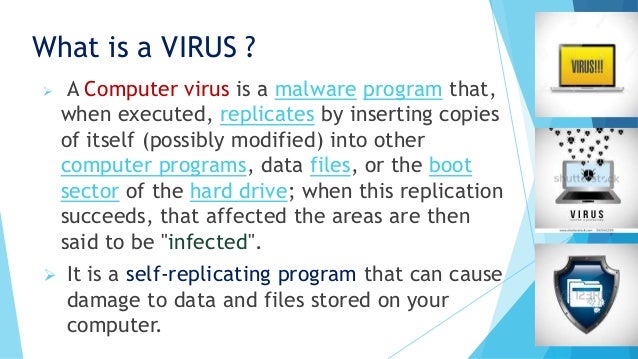Type Of Computer Virus Pdf Infected
Jump to Viruses and the Internet - A computer virus is a type of malicious software program ('malware') that, when executed, replicates itself by modifying other computer programs and inserting its own code. When this replication succeeds, the affected areas are then said to be 'infected' with a computer virus. This lesson explains different types of Computer Viruses different types of Computer Virus like Boot Sector Virus, File Deleting Viruses, Mass Mailer Viruses, Macro.

Computer Viruses – from an Annoyance. Different types of viruses. Object to another computer User transmits an infected object to another computer.

Contents Introduction Viruses, worms, Trojans, and bots are all part of a class of software called malware. Malware or malicious code (malcode) is short for malicious software. It is code or software that is specifically designed to damage, disrupt, steal, or in general inflict some other “bad” or illegitimate action on data, hosts, or networks. There are many different classes of malware that have varying ways of infecting systems and propagating themselves. Malware can infect systems by being bundled with other programs or attached as macros to files. Others are installed by exploiting a known vulnerability in an operating system (OS), network device, or other software, such as a hole in a browser that only requires users to visit a website to infect their computers.
The vast majority, however, are installed by some action from a user, such as clicking an e-mail attachment or downloading a file from the Internet. Some of the more commonly known types of malware are viruses, worms, Trojans, bots, back doors, spyware, and adware.
Damage from malware varies from causing minor irritation (such as browser popup ads), to stealing confidential information or money, destroying data, and compromising and/or entirely disabling systems and networks. Malware cannot damage the physical hardware of systems and network equipment, but it can damage the data and software residing on the equipment. Malware should also not be confused with defective software, which is intended for legitimate purposes but has errors or bugs. Classes of Malicious Software Two of the most common types of malware are viruses and worms.
These types of programs are able to self-replicate and can spread copies of themselves, which might even be modified copies. To be classified as a virus or worm, malware must have the ability to propagate. The difference is that a worm operates more or less independently of other files, whereas a virus depends on a host program to spread itself. These and other classes of malicious software are described below. Viruses A computer virus is a type of malware that propagates by inserting a copy of itself into and becoming part of another program.
It spreads from one computer to another, leaving infections as it travels. Viruses can range in severity from causing mildly annoying effects to damaging data or software and causing denial-of-service (DoS) conditions. Almost all viruses are attached to an, which means the virus may exist on a system but will not be active or able to spread until a user runs or opens the malicious host file or program. When the host code is executed, the viral code is executed as well. Iseki Hydraulic Manual Transmissions more.
Normally, the host program keeps functioning after it is infected by the virus. However, some viruses overwrite other programs with copies of themselves, which destroys the host program altogether.
Viruses spread when the software or document they are attached to is transferred from one computer to another using the network, a disk, file sharing, or infected e-mail attachments. Worms Computer worms are similar to viruses in that they replicate functional copies of themselves and can cause the same type of damage. In contrast to viruses, which require the spreading of an infected host file, worms are standalone software and do not require a host program or human help to propagate. To spread, worms either exploit a vulnerability on the target system or use some kind of to trick users into executing them. A worm enters a computer through a vulnerability in the system and takes advantage of file-transport or information-transport features on the system, allowing it to travel unaided. Trojans A Trojan is another type of malware named after the wooden horse the Greeks used to infiltrate Troy. It is a harmful piece of software that looks legitimate.